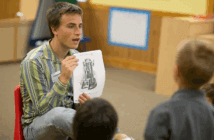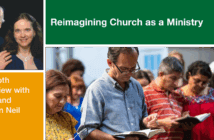Perhaps there was a time when inspiring worship and great music brought people to church. Today, however, in an increasing number of places, the quality of what is happening within the church is not enough to reach those outside the church. Those outside the church, including the growing number of those who state their religious preference as “none,” seek more from the church. They demand authenticity. And even those with no connection to the church understand that an authentic church is a serving church. They respect a church that reads Matthew 25 on Sunday and spends their time and money with the “least of these” during the week. They expect engagement with the community.
Our call to make disciples and our call to serve come together when we engage our entire community and build positive, incarnational relationships with those we encounter.
How can our churches continue to be faithful to the call in Matthew 28 to go make disciples while being increasingly faithful to the call in Matthew 25 to feed the hungry, clothe the naked, welcome the stranger, and visit the prisoner? Where both of these passages come together is in what many today refer to as a church’s “mission field.” Your mission field goes well beyond your membership to include all the people around you whom God has called your particular church to serve. Our call to make disciples and our call to serve come together when we engage our entire community and build positive, incarnational relationships with those we encounter.
Listen and Learn
The best way to learn about the mission field around your church is to listen and learn. While demographic reports from public and private resources offer much data about a community, you cannot discover your mission field exclusively by studying reports. Data must be tested by walking around and spending time with the people who live in your community. Ministries that bless communities in Jesus’ name often arise out of unorganized, crazy, and chaotic conversations where we listen for the hopes and dreams of people within a mission field.
This begins not with big events or large numbers of people. It involvesface-to-face conversations sitting in a park, a diner, or a coffee shop. A pastor sat at Venice Beach, California, with a sign that read, “Tell me your story and I will give you a dollar.” A line formed, and she was busy all afternoon!
As you listen, don’t let your pre-set ideas or preconceived notions shape the conversation. Rather ask simply what are the challenges, hopes, longings, and dreams of your neighbors. As you observe and listen, determine if there are clusters of themes, dreams, and challenges that face people in your mission field. What ministries might address the brokenness revealed?
You may discover that there are already places within your church where you can build meaningful relationships with members of your community — for example, the participants in your English as a Second Language (ESL) program, the neighborhood youth who play basketball in your parking lot, the households who utilize your food pantry and clothing bank, or the families who receive your annual Thanksgiving baskets. Yet too often these programs operate in ways that inhibit positive relationships and communicate an “us and them” attitude.
Turning Missional Gestures into Missional Encounters
A congregation in southern California discovered that their food and clothing bank was inadvertently communicating, “You are not worthy to come to worship, but you can come to the back of the church for a handout.” As a result, very few people were attending their Spanish language worship service. They turned their program upside down so as to incorporate worship, food, clothing, and fellowship into a more unified whole, resulting in exponential growth.
A congregation in Wichita, Kansas, offers a 30-minute worship time after their ESL program each week. About 125 of the 150 ESL participants stay for worship. In central Virginia, a new rural church, working with de-churched people, began as a movement to love and care for neighbors through ministries such as GED classes and a Thrift Store. Only after the community relationships were built did they begin to offer worship. Several churches in the Dallas area have added Bible studies and midweek worship inside their clothing bank for the households that rely on that program. In Dayton, Ohio, a church has added a donut and coffee table to their weekly food and clothing distribution. A church member with the gift of warm hospitality serves as host, inviting each person to stay for the 30-minute Bible study that morning.
These congregations are finding ways to make disciples and serve, fulfilling the Gospel mandates in both Matthew 25 and Matthew 28.
Related Resources:
- The Go-To Church by Brian Collier
- Connect with Your Neighbors Resource






